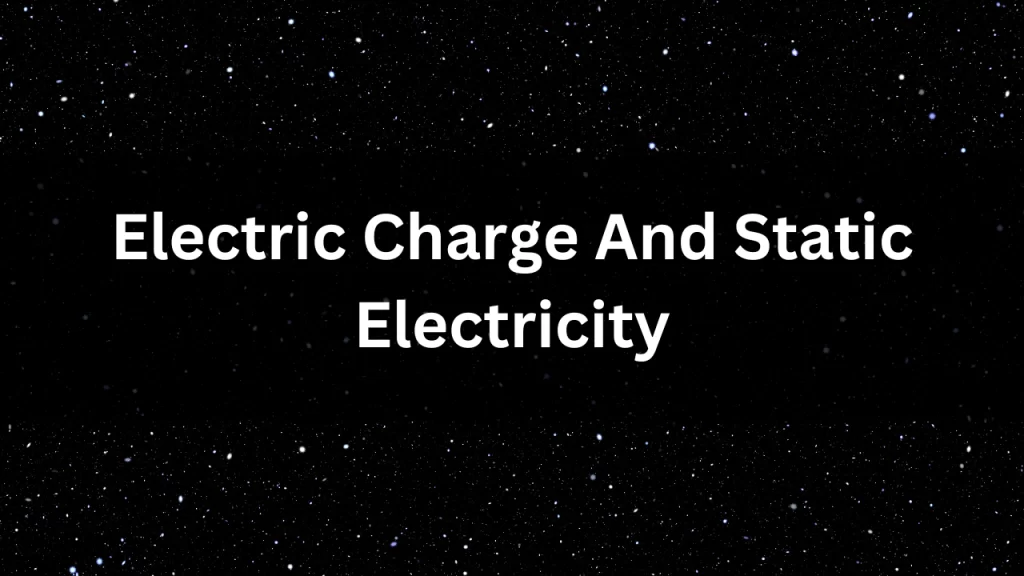Electric Charge And Static Electricity: Certainly, I’d be happy to provide a more detailed explanation of electric charge and static electricity.

Electric Charge And Static Electricity
Definition of Electric Charge:
The Electric charge is a fundamental property of subatomic particles, such as electrons and protons. It is a property that gives rise to electromagnetic interactions between particles. There are two types of electric charge:
Positive Charge:
This is the type of charge that protons possess. Protons have a positive electric charge.
Negative Charge:
This is the type of charge that electrons possess. Electrons have a negative electric charge.
Electric charges interact with each other through electromagnetic forces. Like charges repel each other (positive repels positive or negative repels negative), and opposite charges attract each other (positive attracts negative).
Static Electricity:
Static electricity is a phenomenon that occurs when there is an imbalance of electric charge on the surface of an object.
This imbalance can happen due to various processes, including friction, contact, and induction. Here’s how it works:
What is Friction in Electric Charge And Static Electricity:
When two materials rub against each other, electrons can be transferred from one material to the other.
The material that gains electrons becomes negatively charged, and the material that loses electrons becomes positively charged.
For example, when you rub a balloon against your hair, electrons from your hair are transferred to the balloon, leaving your hair with a positive charge and the balloon with a negative charge.
Contact:
When two objects with different charges come into contact, electrons can move from one object to the other until their charges become more balanced.
This can result in one object becoming positively charged and the other becoming negatively charged.
Induction:
Induction involves the redistribution of charges within an object without direct contact with another charged object.
When a charged object is brought near a neutral object, the charges within the neutral object can shift, causing one side to become more positively charged and the other side more negatively charged.
Static electricity is more noticeable in certain conditions, such as when the air is dry, because dry air is a poor conductor of electricity. This means that electric charges do not easily flow through the air, allowing them to accumulate on the surface of objects.
Common examples of Electric Charge And Static Electricity include:
- Getting a shock when you touch a doorknob after walking across a carpet.
- Seeing your hair stand on end when you rub a balloon against it.
- Observing sparks when you touch a metal object after shuffling your feet on a rug.
Static electricity has various applications and implications, from industrial processes to everyday phenomena like lightning during storms.
It’s important to manage static electricity in certain contexts to prevent hazards, such as the ignition of flammable materials.
Read more.
- CBSE Class 10 Basic Maths Question Paper 2020 With Solutions
- CBSE Social Science Class 10 Question Paper 2020 With Answers
- 10th Class All Subject Books Hindi Medium NCERT PDF Download
- Class 10 All Subjects Books NCERT PDF Download in English
Frequency Question FAQ Electric Charge And Static Electricity
What is electric charge?
Electric charge is a fundamental property of subatomic particles, such as electrons and protons. It is responsible for electromagnetic interactions between particles and is categorized as positive or negative.
What are positive and negative charges?
Positive charges are associated with protons, while negative charges are associated with electrons. Like charges repel each other, and opposite charges attract each other.
What is static electricity in Electric Charge And Static Electricity?
Static electricity refers to the accumulation of electric charge on the surface of an object due to processes like friction, contact, or induction. It is characterized by an imbalance of charges, resulting in attractive or repulsive forces.
How does static electricity occur?
Static electricity can occur through processes like friction, where materials rub against each other and exchange electrons. Contact between objects with different charges can also lead to static buildup. Induction involves redistributing charges within an object without direct contact.
Why is static electricity more noticeable in dry conditions?
Dry air is a poor conductor of electricity, so electric charges do not easily dissipate into the environment. This allows charges to accumulate on the surfaces of objects, leading to a greater buildup of static electricity.
